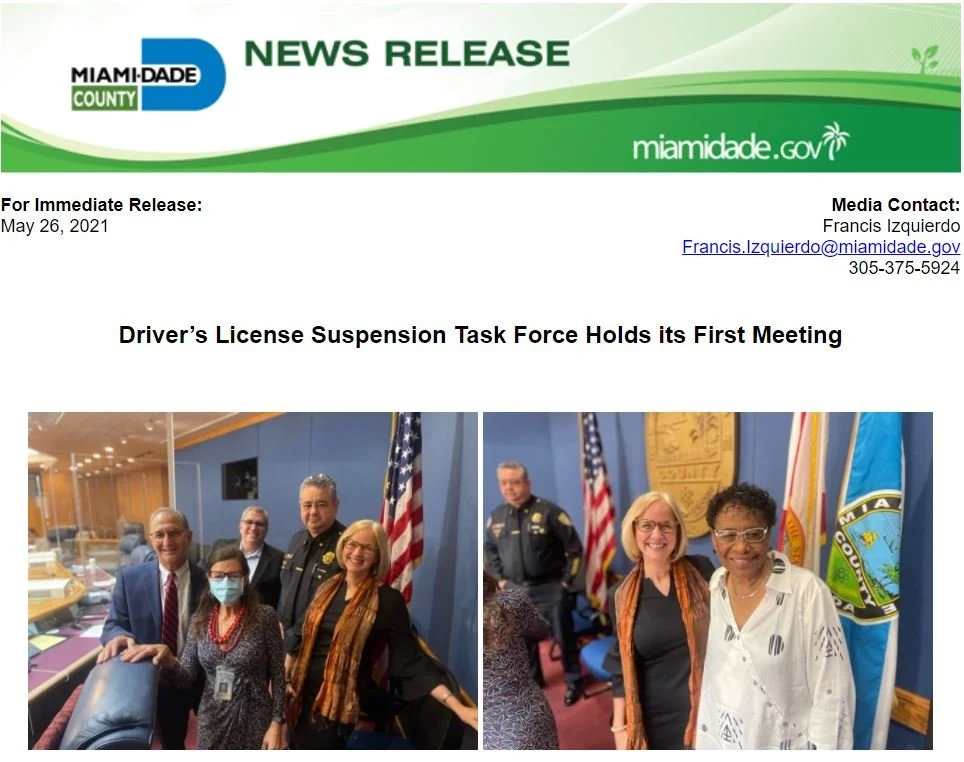
Fines & Fees Justice
Improving economic resilience by reducing avoidable license suspensions in Miami-Dade County.
All design & materials on this project are owned by Ker-twang.
Background
In 2020, 630,000 Miami-Dade residents had suspended licenses —94% due to unpaid fines or missed court dates, not dangerous driving.
This disproportionately impacted low-income residents, limiting access to jobs, housing, and financial stability.
A lack of coordination between courts, the DMV, law enforcement, and advocacy groups further complicated efforts to create equitable solutions.
Design Process
To address these systemic issues, we used a participatory design approach, co-designing with impacted residents, aligning agencies through multi-stakeholder workshops, and used behavior design research to uncover barriers and drive equitable, data-informed solutions.
-
Conducted qualitative interviews with residents who had suspended licenses to understand barriers to reinstatement.
Led workshops with government agencies, legal experts, and community advocates to map pain points in the system.
Examined policy landscapes and financial data to assess economic impact.
-
Co-designed a Driver’s License Suspension Task Force, bringing together the Clerk of Courts, FLHSMV, traffic judges, legal aid groups, and state legislators.
Developed alternative solutions to license suspension, including payment plan options, fee forgiveness programs, and streamlined court navigation tools.
-
Piloted a text-message notification system to remind residents of deadlines and alternative compliance options.
Designed a clearer, more accessible guide to help residents understand their options for license reinstatement.
My contribution
I co-led service design, research, and facilitation, ensuring that our approach was participatory and trauma-informed. My core team was made up of myself and two other designers. Stakeholders included:
Policy experts & legal advocates (to assess regulatory constraints)
Community organizers (to ensure resident perspectives were centered)
Government agency representatives (to secure buy-in and feasibility)
Design deliverables that furthered the work included:
Journey maps of residents navigating license reinstatement
Service blueprint outlining touch points that presented barriers for residents across the multiple agencies they had to interact with
Mockups of simplified reinstatement guides, citation notices, payment portals, court navigation documents and more
Policy Changes Implemented
As a result of our efforts, several key policy reforms were implemented to make the system more equitable:
Reinstating Eligible Drivers: Efforts were made to clear the backlog of non-dangerous drivers eligible for license
reinstatement through outreach and assistance programs.
Establishing a Driver’s License Compliance Court: A specialized court was created to handle cases of license
suspensions due to unpaid fines, streamlining resolution.
Reducing Arrests for Driving with a Suspended License: Policies were adjusted to decrease arrests related to license suspensions stemming from failure to pay, focusing on non-dangerous drivers.
Developing Contactless Compliance Tools: Online and remote tools were introduced, allowing residents to address fines and compliance issues without in-person visits.
Improving Communication and Customer Experience: Enhancements were made to ensure residents receive clear information about their license status and steps needed for reinstatement.
Simplifying the Payment Process: The payment system was restructured to be more user-friendly, including options for payment plans to accommodate various financial situations.
Establishing Tracking and Oversight: The Mayor’s Office was tasked with overseeing the implementation of these reforms, ensuring accountability and progress tracking.
Project Outcomes
The creation of an official Task Force, which led to policy changes reducing unnecessary suspensions.
Increased access to payment plans and alternative compliance options.
A redesigned notification system, reducing missed court appearances.
Learnings
This project highlighted the power of cross-agency collaboration and the need to balance competing priorities while keeping residents' needs central.
Engaging people directly impacted by fines and fees ensured solutions were practical, while embedding judges, commissioners, and agency leaders early turned them into champions of the work, driving stronger adoption.
Navigating political dynamics required strategic communication—framing critiques as opportunities for improvement to motivate, not alienate, decision-makers.
User Research
We mixed human stories with data to build momentum for implementing solutions.
We conducted in-depth research to understand the common and consequential non-driving related barriers to keeping and maintaining a license.
We engaged directly-impacted community members in design.
Designing Scalable Solutions, Final Task Force Recommendations

